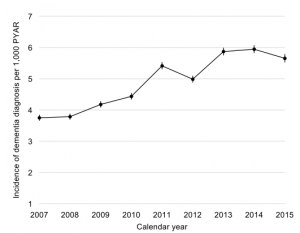“Why am I doing this?!” A reminder.
By guest blogger, on 6 September 2018
In this post Betsy Jones (UCL Research Department of Primary Care and Population Health) writes about her experience of attending the Alzheimer’s Association International Conference and why we do the work we do.
I have been assured that asking oneself “Why am I doing this?!” is not an experience unique to any one stage of a research career. The key is having a good answer.
At the height of the British summer heat wave, I travelled to Chicago, to give an oral presentation to the Alzheimer’s Association International Conference (AAIC) on a project I’ve joined, funded by the Dunhill Medical Trust, addressing inequality in primary care of people with dementia among UK ethnic groups.
The first phase of the project has already been published in Clinical Epidemiology and found that dementia diagnosis incidence was significantly higher in Black men and women compared to White men and women, respectively, and was significantly lower in Asian women compared to White women. Tra recently wrote a blog on this below. I presented these results along with new results showing inequality by ethnicity in prescribing of certain drugs among patients with dementia.
The presentation itself went smoothly, and I breathed a sigh of relief as I walked off stage. With the nerves and the bright lights out of the way, I was excited to find that a queue of people were keen to talk with me about the project.
Multiple researchers expressed how grateful they were that someone was looking into this area, highlighting that while the demographics of many developed nations are changing, the research has not often kept up. Others wanted to share personal experiences, speaking of the reluctance of family members to seek a diagnosis or medication even as their condition progressed, especially when cultural factors around memory problems and fear of stigma were at play. These conversations made clear that the need to identify inequalities and break down barriers to good quality care was not a problem unique to the UK, but everyone I spoke with reinforced how important it was to see that we’re working on it.
In the midst of Stata code, funding applications, and reviewer comments, we can lose sight of the goal. As researchers, we have the privilege of generating work that can improve peoples’ lives. We can be reminded of that by our Patient & Public Involvement advisors, our colleagues, or a review of the “Impact” section of our own funding application (and hopefully by this blog post). My conversations with a variety of people after my presentation was a wonderful reminder of the goal and impact of this project. I hope you can take a moment today to remember the goal of your work too, because you’re doing this for a good reason!
 Close
Close


